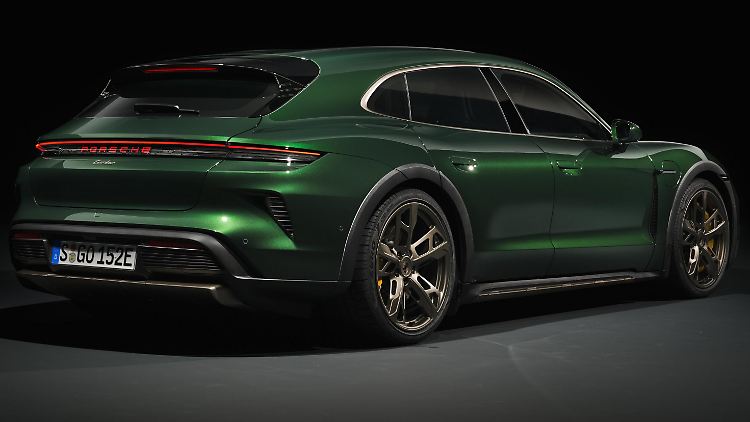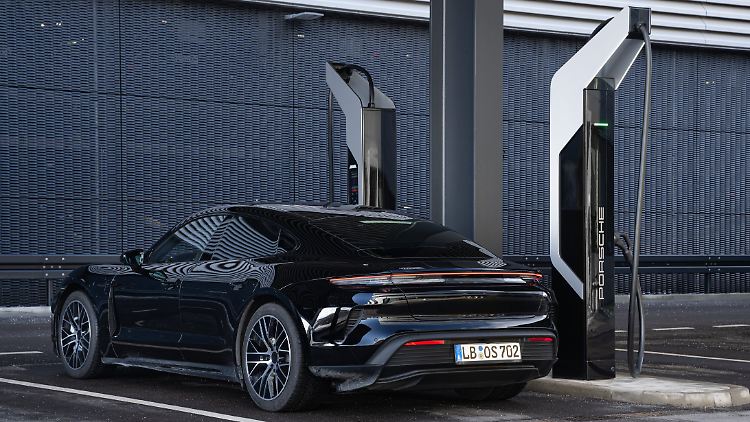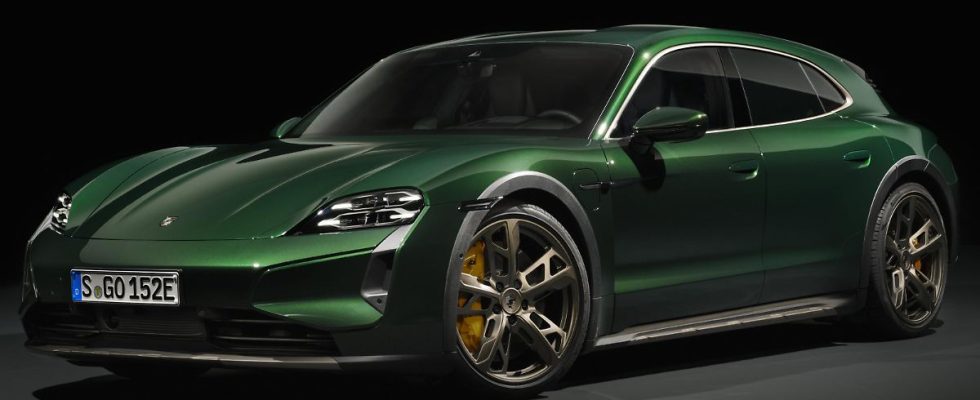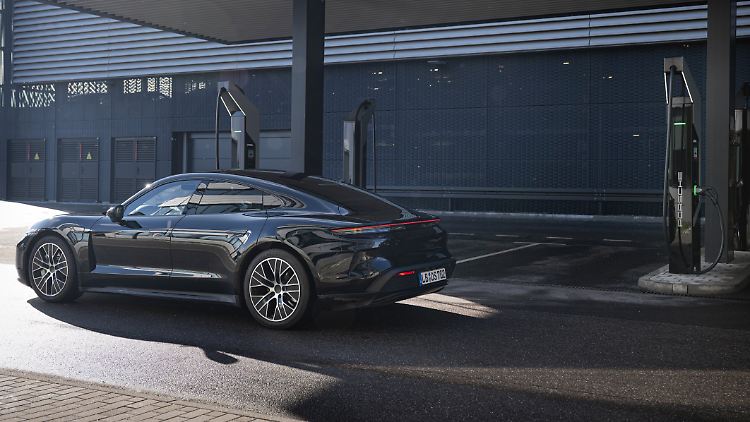Porsche unveils the facelift Taycan including technical details and has already invited people to take a test drive. Is the electrically powered Zuffenhausener now becoming a Model S plaid horror? Not yet, but there is definitely a superlative.
Porsche was a bit mean when presenting the Taycan facelift model. The program included several hours for a technology workshop before the revised electric tourer was set to go to the charging station. But the mean thing was to ignore the top speed on all the many charts with lots of exciting data. When I asked, I found out: It stays at 260 km/h.

The Porsche logo on the second series Taycan can now light up. It’s probably trendy.
(Photo: Porsche)
Sounds a bit banal, don’t you think, to dwell on such a triviality? Well, maybe – but the Tesla Model S Plaid, which is somehow always present in my mind, does 320 km/h. This may be a bit extreme for some tastes, but sexy nonetheless. However, the top performance of the Turbo S appears relatively quickly on the chart: 952 hp. Oof. Of course, I explicitly ask whether Porsche would like to leave it at that. So in terms of all performance data, it ranks a little below the Plaid or a top Lucid Air model. The series manager grins broadly at me. All clear, message understood.
Then I continue to listen to the explanations of various technicians. The Taycan has been fundamentally addressed. The rear engine has become more efficient and lighter. New chassis features are intended to delight those interested in dynamic driving and people with an affinity for technology as well. The charging management has been completely overhauled. There are new layouts for the ads. New software provides additional functions. And a new cell chemistry is being used in the battery with the aim of higher energy density. And hey presto, the battery capacity of the large battery version climbs from 93 to 105 kWh while weighing nine kilograms less.
Reducing weight with the Taycan is a real Sisyphean task. Two kilograms fell here thanks to the new power electronics and ten there because of the new unit. Overall, the engineers only saved 15 kilograms because certain components have become heavier. And at the end? We still have around 2.3 tonnes on the scales. The high-tech electric car is still not a lightweight.
The aha moment comes when loading
Okay, the tension is rising: we’re about to go into the hands of a developer of the deeply modified Taycan, who was still in disguise at this time in January. Here and today just in the passenger seat. It goes without saying that the Taycan drives incredibly fast, but my accompanying engineer wants to prove to me that it also charges ultra-fast. So we go from the small community of Friolzheim to the famous development center in Weissach, where there are a number of Porsche Hyperchargers. Just for information, I’m asking which version I’m on. It is the usual turbo (without “S”) with now a measly 884 hp overboost power. As a reminder: the Turbo S used to have “only” 761 hp. It’s mainly on lonely country roads. On one or two straights my driver gives full load and – wow, I’m stuck in the seat quite nicely. So far, so to be expected.


The revised Porsche Taycan doesn’t stand at the charging station for long. At least that’s what Porsche promises.
(Photo: Porsche)
But then an unexpected aha moment comes. We control the charging station after the battery is well warmed up, plug it in – at 37 percent state of charge. There isn’t much time because other colleagues also want to have a turn. The stopwatch is running, the Taycan has been at the charger for exactly 172 seconds. During this short period, the charge level rises to 50 percent with around 300 kilowatts of charging power. The technicians were also able to speed up the communication process between the battery and the charging station.
The engineers also managed to reduce the so-called comfort temperature of the battery from 35 to 15 degrees Celsius – once it reaches this optimal window, it charges quickly. This results in a significant speed advantage, especially in the cooler season. The technicians have also achieved an improvement in the charging curve. After the short charging stop, we hurry back to Friolzheim.


The infotainment of the new Taycan expansion stage should be able to do a lot of new things.
(Photo: Porsche)
Before this Taycan episode ends, you, dear reader, should get some more data. For the flagship Turbo S, the manufacturer quotes 2.4 seconds to reach 100 km/h. It should be able to do 200 things in a little less than 8 seconds. If this value turns out to be reproducible, the Turbo S should be the fastest four-door car on the market – with the top models from Lucid and Tesla there would at least be a question mark, but the potential to keep up would of course theoretically be there.
It remains exciting to see under what practical conditions the significantly increased WLTP range of 678 kilometers (previously a maximum of 416 kilometers for the Turbo S) can actually be achieved. But that needs to be clarified later, including detailed explanations of the efficiency measures. And according to Porsche, the charge level can be increased from 10 to 80 percent within 18 minutes. The power peak when charging should be reached at 320 kilowatts (previously 270).
Optimizing charging performance is important to Porsche
The detailed discussion of the chassis with the two-chamber air suspension (one of Porsche’s favorite features) was postponed – apart from the ease of entry: If you open the door, the Taycan literally jumps up on this side to make boarding more pleasant – there was not like that yet. And some of the gimmicks that the revised infotainment has in store need to be looked at in more detail.
But I find one feature really interesting. The driver can now observe the temperature window of the electricity storage system. The impossibility of reproducing charging performance is something that causes widespread frustration in the context of electromobility. Basically, you never know how much charging power the vehicle is currently capable of. And this is exactly the information the on-board computer of the second series Taycan now outputs. This means the driver knows whether he should act a little more boldly or more cautiously before driving to the charging station in order to optimize the charging performance.
The basic Taycan with 408 hp maximum output (4.8 seconds to 100 km/h) starts at 101,500 euros. Another new performance level is the 4S with 544 hp (3.7 seconds for the standard sprint) at 120,900 euros. The Turbo, which sprints to country road speed in 2.7 seconds, costs 175,600 euros, while the top model Turbo S costs 209,900 euros. Derivatives such as Sport and Cross Turismo are still available – at slight additional prices.
The WLTP consumption level is around 17 to 22 kWh per 100 kilometers. It used to be around 4 kWh more. The question remains whether the Tesla Model S plaid killer will come along, which will then deliver the four-digit horsepower that some interested parties are longing for – and of course a top speed of at least 300 km/h. I bet a Taycan like this is coming later this year.


